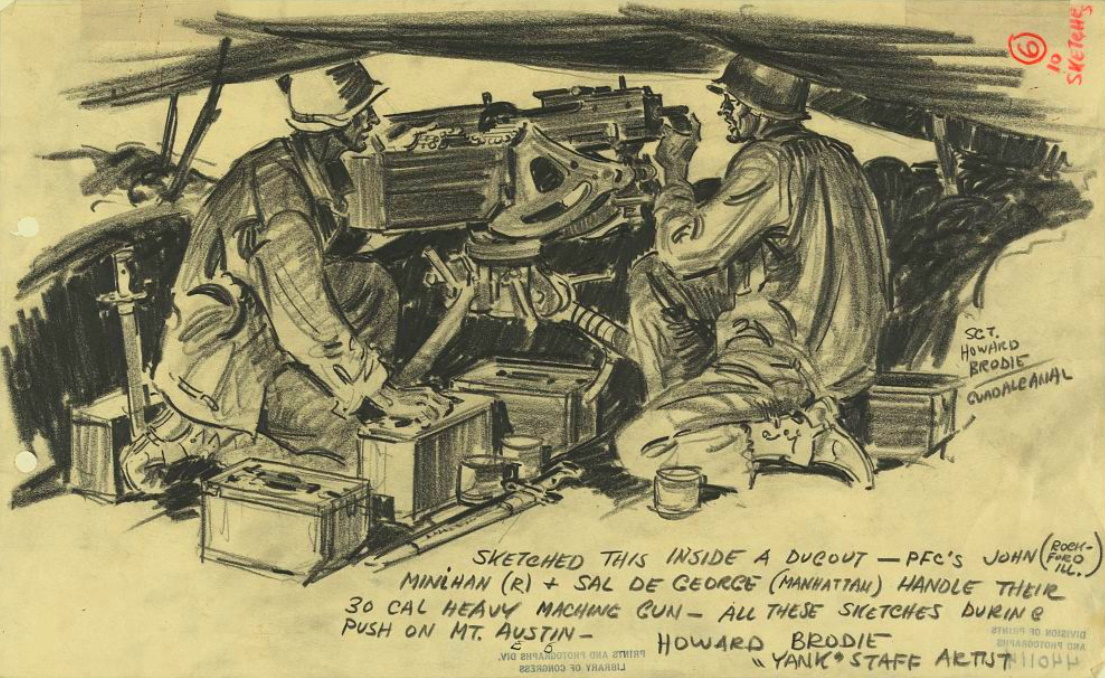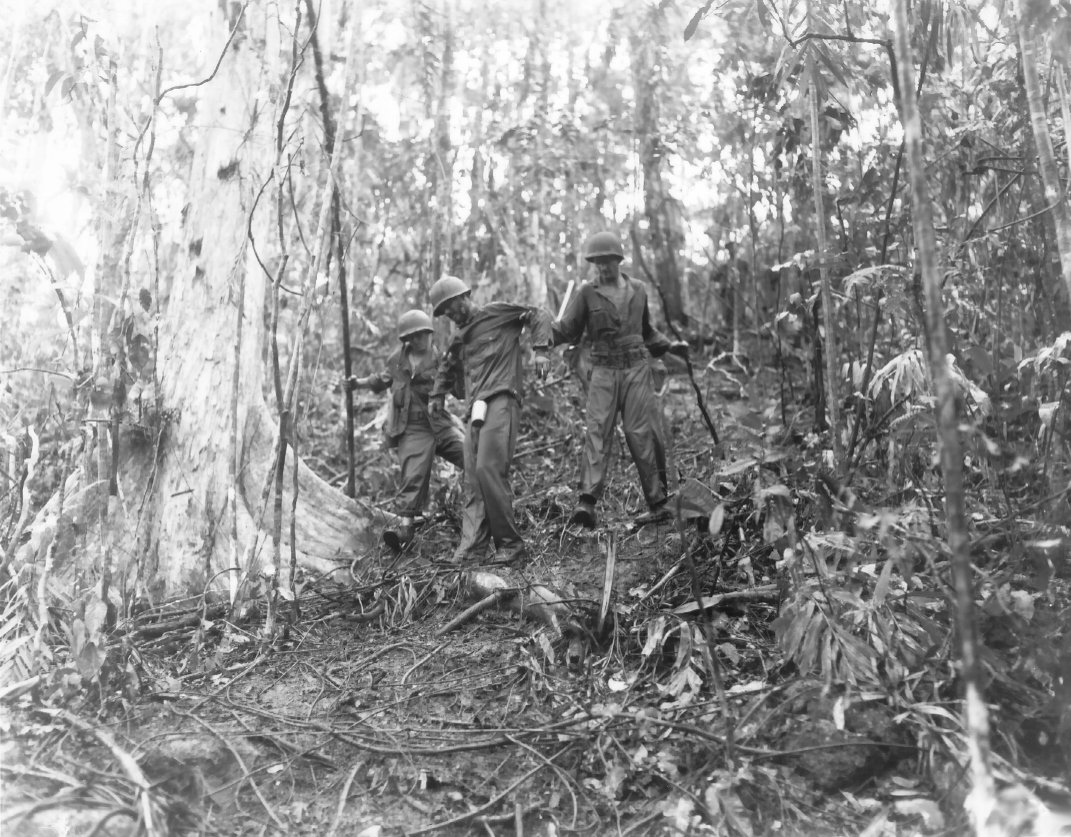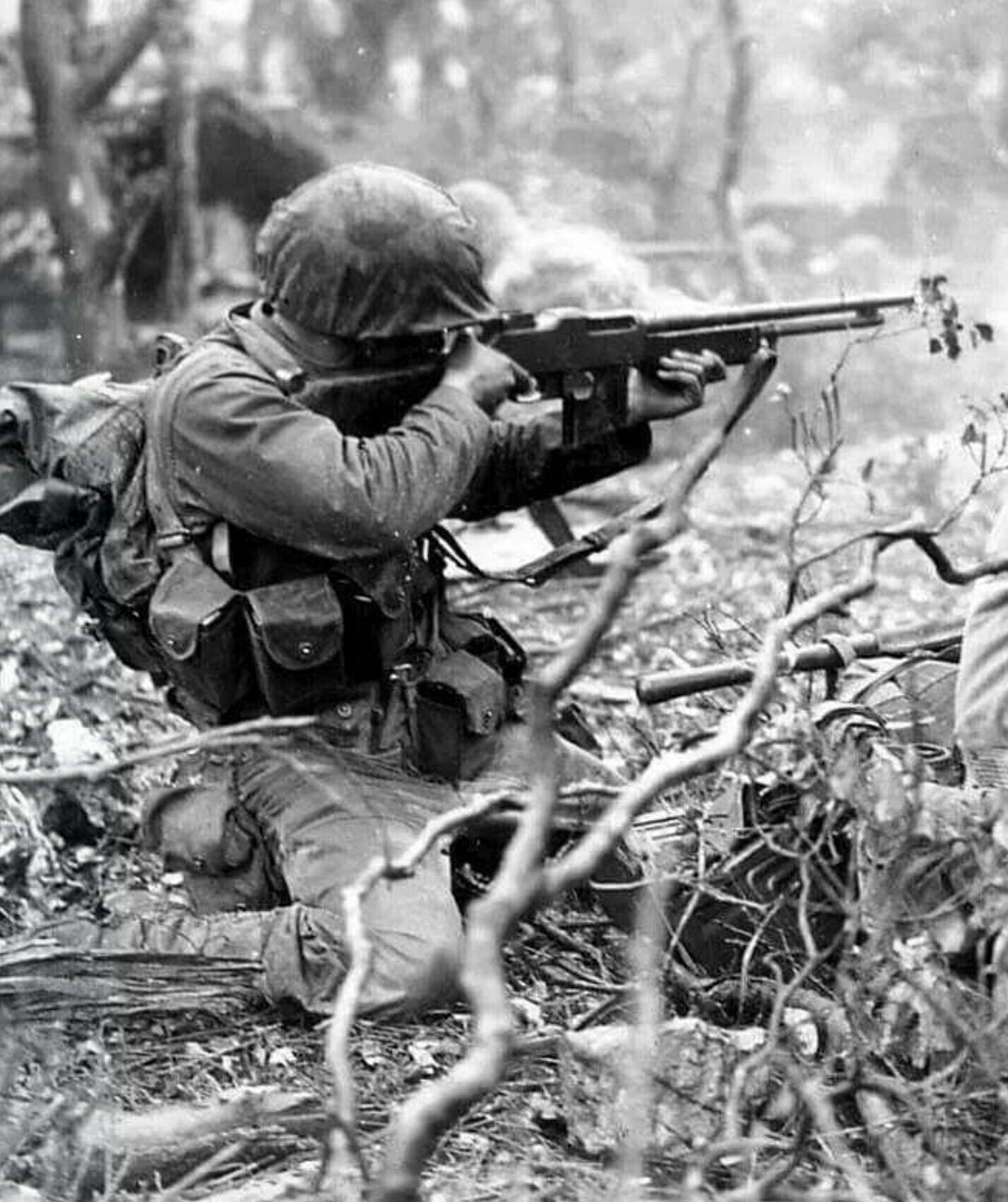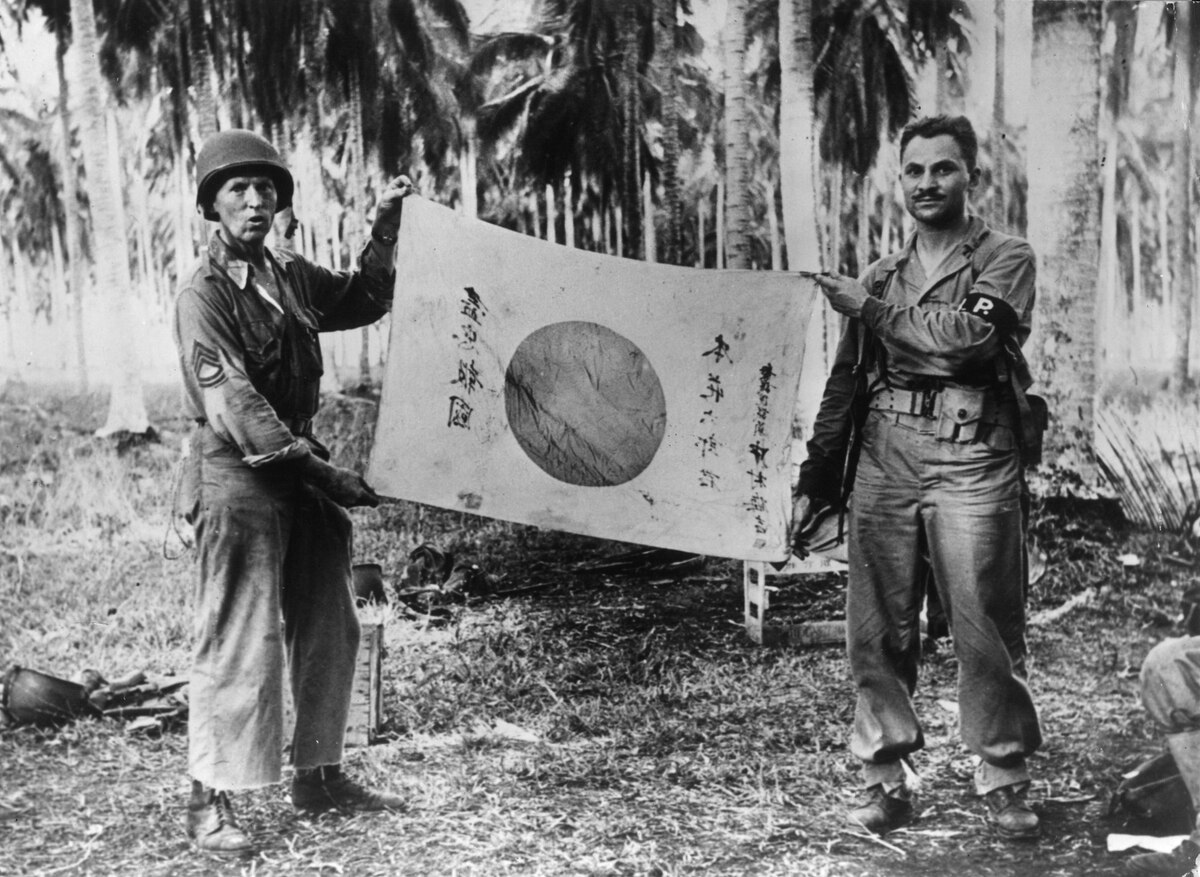The timely arrival of Gen Alexander M. Patch (XIV Corps Commander) and Gen J. Lawton Collins (25th Infantry Division Commander), resulted in a company of Marines being scheduled on the day of the attack to secure the line to the boundary ensuring the safe passage of the 27-IR troops to that point. Based on available enemy information furnished by the Marines, the division commander promised the massing of the fires of the Division Artillery and possibly an air attack on the known enemy resistance in the ravine between Hill 66 and the hoof of the Horse’s foreleg. Following the final settlement of the boundary dispute, the regimental commander’s plan of action was complete. The 1/27-IR, (Lt Col C. E. Jurney), was to attack from the north from Hill 66 and seize the Horse’s forelegs and Hill 57. The 3/27-IR, (Lt Col G. E. Bush), would pass through the 1/2d Marine on Hill 55, and Hill 54 and seize Hills 50, 51, 52, 53. The 2/27-IR (Lt Col H. V. Mitchell) would remain in the regimental reserve in the general vicinity of Hill 55. The Cannon Company was to be in general support of the regiment. The AT Company was attached to the 3/27-IR to hand-carry food, water, and ammunition.
So, on January 9, 1943, the entire regiment was in forwarding assembly areas. The 1/27-IR was located in a ravine on the east slope of Hill 66; the 3/27-IR was at the base of Hill 55; the 2/27-IR remained in a bivouac near the beach to avoid too much confusion in the forward area but scheduled to make a short march early the next morning to a vicinity near Hill 55. The regimental command post was established on the east bank of the Matanikau River at the base of Hill 65.
ATTACK OG THE GALLOPING HORSE
On January 10, 1943, the attack on the Galloping Horse began at 0550 by the massing of the fires of the Division Artillery plus one battalion of Marine Artillery on the known enemy positions in the ravine between Hill 66 and Hill 67. The artillery concentration lifted at 0615. Navy dive bombers then began dropping depth charges on the same target. Following the aerial bombardment, Fox Co, 2d Marine closed the gap between the division’s right boundary and the 2d Marine without difficulty. The Marines were immediately followed by Baker 1/27-IR, which established a block across the ravine without resistance as a result of the successful artillery and aerial bombardment. The Recon Squadron also occupied their block on the schedule. At 0730, after Baker 1/27 had reported being in position, the 1/27 moved in a column of companies to attack Hill 57. The battalion captured its objective at 1140 after only slight resistance from enemy automatic weapons. The crest of Hill 52, the intermediate objective of the 3/27, commanded the entire Galloping Horse area on three sides. The fourth side or southeast side was almost a sheer cliff, heavily wooded, which could easily protect defenders from our fire. In addition to its grim appearance, the dominant thought in the minds of the 3/27 was that the Marines had twice been repulsed in attacks on this hill, the second time with heavy losses. Immediately following the artillery and aerial bombardment, the 3/27 moved across the line of departure with Item Co on the right and Love Co on the left, attempting a double envelopment.
A base of fire including 37-MM AT guns was then established on Hill 54. Love Co on the left occupied Hill 51 without opposition. Leaving a platoon there to cover their flank and rear the company moved toward Hill 52. After advancing to within 200 yards of the objective, the company was stopped by enemy machine gun fire. Meanwhile, Item Co on the right met resistance from the Jungle on their right flank. The accurate fire of the snipers in the jungle kept a platoon occupied for the better part of the day. The company did advance to within 200 yards of the crest of Hill 52 before, being stopped by superior enemy fire. The battalion CO, having failed to knock out the resistance with his supporting weapons, committed his reserve, attempting a deeper envelopment of the enemy’s left. In the meantime, an air mission was made available to the battalion commander. The squadron commander personally came to the battalion observation post to view the target area and determine exactly where the bombs were to be placed. While waiting for the air mission, intermittent artillery and mortar fire were placed on the target. King Co, before moving into position on the far right had to clear a small ridge of the enemy to protect their rear.
At 1445, the planes appeared overhead. As planned, the artillery fired a smoke shell to mark the target but the round fell short near the battalion observation post, narrowly missing a group of men. Quick thinking on the part of the battalion commander and teamwork by the 81-MM mortar platoon placed a smoke shell on the objective before the planes started into action. The six planes then each accurately dropped one depth charge two of which failed to explode, on the south slope of Hill 52. Immediately following the strafing by the planes, a heavy artillery concentration was placed on the objective. Item and King Cos then moved in rapidly to assault the objective with bayonets fixed. At 1625, Hill 52 was in the hands of the 3/27. Since no further action could be made that day, the regimental CO directed that all units establish a cordon defense. Easy Co was moved to occupy Hill 50 and establish a block to the Matanikau River. Fox Co occupied Hill 51. During the night sporadic enemy artillery and mortar fire were received in the unit positions.
The following day 3/27 continued the attack. The plan was to move Love Co along the right to Hill 57, join the 1/27, and then extend south across the jungle to the Horse’s mouth. Item Co was to attack to the southwest, seize a small ridgeline between Hill 52 and Hill 53 and then King Co would pass through and secure Hill 53. The attack was scheduled for 0900 but by that time only a few gallons of water had been delivered by the carrying parties to Hill 52. However, following an artillery preparation, the companies moved out in the attack with most of the canteens in the battalion completely empty. Love Co advanced as scheduled to the southeast slope of Hill 57. Here it began receiving fire from enemy rifles and automatic weapons from three directions. As they were not in view of the 1/27 and could not advance or withdraw, they dug in. Item Co reached the base of the small ridgeline between Hill 52 and Hill 53 but began receiving fire from enemy automatic weapons. The lack of water soon began to tell on the assault units. Exhaustion, casualties began trickling back and forward movement ceased.
As the day wore on the men became more thirsty and exhausted and leaders were lacking in the push necessary to put the attack across. It was noted that as the going became harder, leadership became more important. When things did not run smoothly, a forceful leader was essential to pull out of the difficult position. In spite of the heat and exhaustion that day, the enemy positions could have been overcome if the leaders had shown the push and determination that they had the day before. About noon, it was seen that the battalion would be unable to continue to the objective and it was withdrawn to its original positions on Hill 52. Love Co also returned from Hill 57 after the enemy opposing them had withdrawn. That night a small enemy attack on the right flank of the 3/27 was repulsed. The 2/27 passed through the 3/27 at 0630 on the following morning, having approximately the same plan of attack as the 3/27. George Co on the right proceeded to occupy by 1200 their portion of the battalion objective on Hill 57 with only medium resistance encountered in the Jungle northwest of Hill 52.
Fox Co, meanwhile, maneuvered to the left and gained control of Exton Hill but could move no further due to the intense mortar and machine gun fire coming from Sims Ridge and the Horse’s head. In order to keep the attack moving, Easy Co was committed on the left of Fox Co, but they were also stopped. Fox Co was then disengaged and maneuvered to the north to attack Sims Ridge from that direction. When Fox Co succeeded in securing approximately half of Sims Ridge, the battalion commander believed he could break the Japanese defenses by moving Easy Co to the north and attacking with both companies down the ridgeline. While Easy Co was en route, the base of the fire was moved to Exton Hill. Late in the afternoon, a coordinated attack by the two companies failed to make progress.

 The next day, January 13, the attack again proceeded during a tropical rainstorm. The Battalion Executive Officer, Capt Charles Davis, in attempting to find a way to eliminate the principal machine guns holding up the advance, finally obtained four men of Fox Co to assist him in an attempt against the opposition. Capt Davis and his volunteers wriggled on their stomachs to within 10 yards of the enemy machine guns. Two enemy grenades thrown at the party failed to explode. Capt Davis and his men hurled eight hand grenades into the enemy positions and then assaulted them. Capt Davis’ rifle jammed on the first shot, but he drew his pistol and followed by the others, plunged into the middle of the enemy’s position and wiped them out. Fox Co, seeing the actions of these heroic men silhouetted against the sky, leaped to their feet and moved along Sims Ridge, liquidating the surprised enemy. With the same spirit, they moved on to capture the Horse’s head, Hill 53, leaving many enemies dead in their wake. The regimental objective was completely seized at 1200. Patrolling in the immediate area continued throughout the day to eliminate enemy individuals who by-passed in the final assault.
The next day, January 13, the attack again proceeded during a tropical rainstorm. The Battalion Executive Officer, Capt Charles Davis, in attempting to find a way to eliminate the principal machine guns holding up the advance, finally obtained four men of Fox Co to assist him in an attempt against the opposition. Capt Davis and his volunteers wriggled on their stomachs to within 10 yards of the enemy machine guns. Two enemy grenades thrown at the party failed to explode. Capt Davis and his men hurled eight hand grenades into the enemy positions and then assaulted them. Capt Davis’ rifle jammed on the first shot, but he drew his pistol and followed by the others, plunged into the middle of the enemy’s position and wiped them out. Fox Co, seeing the actions of these heroic men silhouetted against the sky, leaped to their feet and moved along Sims Ridge, liquidating the surprised enemy. With the same spirit, they moved on to capture the Horse’s head, Hill 53, leaving many enemies dead in their wake. The regimental objective was completely seized at 1200. Patrolling in the immediate area continued throughout the day to eliminate enemy individuals who by-passed in the final assault.
The period from January 14 to January 19, was spent in active and aggressive patrolling to the front and flanks. Offensive action could not be resumed until supply roads were completed.
On January 19, the 1/27 occupied the Snake’s Head and Back which had been out-posted since January 17. The 3/27 moved up to occupy the positions vacated by the 1/27. Two combat patrols sent out on January 20 brought back a great deal of information which was very useful in future planning. One platoon-sized combat patrol crossed Hill 87 and reported that it was clear of the enemy but that it had required three difficult hours to reach that objective. The platoon was directed to remain there as an outpost. The other patrol accompanied by an artillery forward observer proceeded down the Snake’s Back. Upon reaching the Snake’s Tail, the platoon with one 60-MM mortar squad attached discovered that they had been allowed to walk into a trap and were practically surrounded by the enemy. The platoon leader called for help while the artillery forward observer calmly proceeded to lay down a curtain of protective fires. The timely arrival of another platoon a short time later extricated the patrol from a serious predicament.
CAPTURE OF KOKUMBONA
The resumption of the offensive to the west was planned for January 22. It was anticipated that the enemy would hold Hill 87 in force since it was the dominating feature overlooking Kokumbona and the surrounding area. The general plan of the division commander placed the 161-IR on the left attacking Hills X, Y, Z, then pushing on to Hill 88, and Hill 89 while the 27-IR reduced Hill 87. The information supplied by the two patrols two days previously was the deciding element in the routes to be followed by the 27-IR, since the route across to Hill 87 was known to be torturous, the 1/27 moved out at 0630 down the Snake’s Back in order of George, Baker, Able Cos with fire support by Dog Co from the high ground in the Snake’s Back. The expected resistance on Snake’s Tail developed but the CO of Charlie Co quickly knocked out the automatic weapons with one 81-MM mortar fire. After reaching the base of Hill 87 at 0910, and killing a few enemy riflemen, the battalion fanned out with the three rifle companies abreast. The battalion swept up Hill 87 encountering no resistance and by 1100 had occupied Hills 87, 88, 89. The 3/27 and the 2/27 in order closely followed the 1/27 to protect the supply lines. Gen Collins, CG 25-ID, upon learning of the rapid advance of the 27-IR, secured verbal authority from the XIV Corps to change the division zone of action, and exploit the breakthrough. He traveled to Hill 89 and personally gave the order to Col McCulloch for the 27-IR to continue the advance to the northwest outflank the enemy and capture Kokumbona.
Although the units had already organized a perimeter of defenses and dug in, they proceeded on at 1400 with great enthusiasm. Supported by Baker and Dog Cos, the other two rifle companies of the 1/27 crossed the heavily wooded ravine between Hill 87 and Hill 90, overrunning the resistance. As determined later from captured documents, the enemy encountered there were manning an artillery command post. After scaling the slopes of Hill 90 Able and Charlie Cos were directed to establish a perimeter of defense and dug in for the night. To strengthen the position of the regiment prior to darkness, the 3/27 was moved up and occupied Hills 89, and 91 linking up with elements of the 1/27 on Hill 90. The 2/27 occupied Hill 87 after joining flanks with the 1/27 on Hill 89. Elements of the 161-IR were securing the supply line to Hill 87.
 The plan of operations for January 23 was to capture the enemy’s supply base at Kokumbona and cut off the escape route of the enemies who were opposing the 6th Marines advancing to the west. To do this the 1/27, with Easy Co attached, was to capture Kokumbona while the 3/27 established a block along Hill 98 and Hill 99 to the sea. The 2/27, less Easy Co, was to follow the 1/27 and protect the regiment’s rear and south flank. On January 23, just as the continuation of the attack started, all the supporting artillery and machine guns in the Marine sector opened up. However, their fire was not all landing on the enemy but overs were plunging into Hill 90 and Hill 91. The regimental commander urgently telephoned the division commander to get these fires under proper control.
The plan of operations for January 23 was to capture the enemy’s supply base at Kokumbona and cut off the escape route of the enemies who were opposing the 6th Marines advancing to the west. To do this the 1/27, with Easy Co attached, was to capture Kokumbona while the 3/27 established a block along Hill 98 and Hill 99 to the sea. The 2/27, less Easy Co, was to follow the 1/27 and protect the regiment’s rear and south flank. On January 23, just as the continuation of the attack started, all the supporting artillery and machine guns in the Marine sector opened up. However, their fire was not all landing on the enemy but overs were plunging into Hill 90 and Hill 91. The regimental commander urgently telephoned the division commander to get these fires under proper control.
After a short period the fires were under control; but not until a few casualties were suffered by the 27th Infantry. It was later determined that the information concerning the location of the 27-IR had not been properly disseminated to the Marines. Following that interruption, the regiment moved on to the objectives for that day. The 3/27, after clearing enemy resistance from the deep ravine between Hill 89 and Hill 90, pushed onto Hill 99 and the sea, thus blocking the enemy’s escape from the east. Meanwhile, the 1/27 was delayed in moving out as a host of snipers had infiltrated into the gorge between Hill 89 and Hill 90. These snipers were mopped up in short order. The battalion moved in two columns via Hill 98, and Hill 99 and after a short skirmish, captured the Japanese main supply base at Kokumbona at 1500. The 2/27, less Easy Co, moved to Hill 90 and joined forces with the 3/27 protecting the south flank of the regiment.
Later in the afternoon, Fox Co was directed to occupy Hill 100. This they succeeded in doing only after overcoming stiff resistance. At this point, it might be well to note what effects the swift capture of Kokumbona had upon the Japanese. During that night, Item Co which was occupying the block to the sea killed at least fifty enemies who blundered into their crossfire. The manner of their approach, which was very noisy and lacked alertness, revealed that they were completely unaware that American troops were in possession of their rear area.
On January 24 and January 25, the 27th Infantry advanced to the Poha River encountering sporadic resistance and capturing great quantities of enemy artillery, ammunition, and other supplies in addition to a few dazed members of the Japanese Imperial Army. As the regiment prepared to continue the drive toward Cape Esperance, an enemy naval force was reported speeding toward Guadalcanal bringing with it the possibility of a Japanese amphibious attack in force upon any of the American positions. In the face of this threat, the 25-ID was withdrawn and placed in corps reserve, the 27-IR was relieved by the 6th Marines, and the 182-IR by the Americal Division.




























